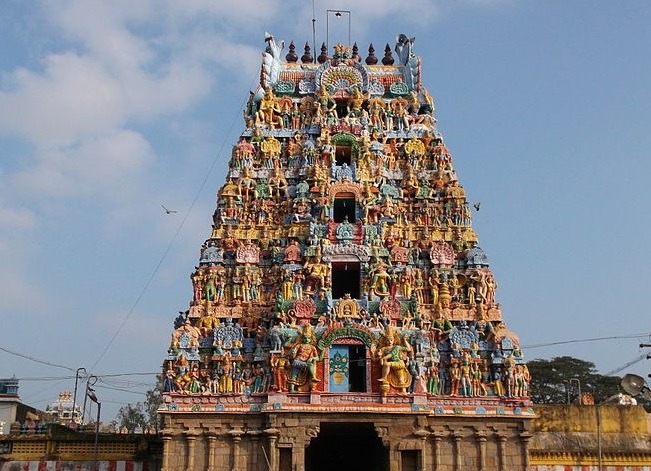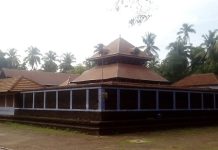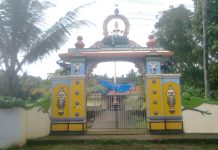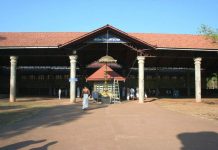The Apatsahayesvarar Temple, also known as the Guru Sthalam or Tiru Irum Poolai, is a Hindu temple located in Alangudi village in the Valangaiman taluk of Tiruvarur district in Tamil Nadu, India. The temple is dedicated to Lord Shiva (name as Apathsaheswarar ) and his consort Parvati, represented by the lingam and Elavarkuzhali, respectively. The temple is also one of the Navagraha temples dedicated to the planet Jupiter or Guru Brihaspati.
The Tevaram, a 7th century Tamil Saiva canonical work written by Nayanmars, classifies this temple as a Paadal Petra Sthalam, one of the 275 temples. The temple is also part of the Pancha Aranya Sthalams, which includes five temples at different forests in the Thanjavur/Kumbakonam/Thiruvarur region. The Alangudi Guru Temple is revered for its association with three holy rivers, the Cauvery, Kolidam, and Vennaru.
The temple is famous for its celebration of Jupiter’s transition from one zodiac to another, as well as other festivals such as Thai Poosam and Chithhtirai Purnima. Devotees consider offering yellow garments to be sacred, reflecting the yellow hue of the planet in pictures.
Legend
According to Hindu mythology, the Alangudi Temple is steeped in ancient tales and beliefs. One such legend involves Lord Shiva, who is said to have ingested the poison of the snake Vasuki during the churning of the ocean by Gods and demons to retrieve the nectar of immortality. It is said that Vasuki’s poison would kill anyone on earth, heaven, or hell if they came into contact with it. To save the three worlds, Lord Shiva consumed the poison himself and was named ‘Apatsahayeswarar,’ which means ‘rescuer’ in Tamil. This act of self-sacrifice gave rise to the name Alangudi, which means ‘place of poison drink.’
Another legend surrounding the temple involves the Pancha Aranya Sthalams, five temples in the Thanjavur/Kumbakonam/Thiruvarur region that are revered as sacred forest sites. The Alangudi Temple is one of these five, and is dedicated to the principal deity Apatsahayeswarar, also known as Aranyeswarar. The temple is also considered one of the Navagraha Temples, with its focus on the planet Guru or Jupiter. It is believed that Lord Shiva is the centre of all Shiva temples in the region, with the Saptha Vigraha moorthis (seven prime consorts in all Shiva temples) located at seven cardinal points around the temple.
History
It is believed that the original complex was built by the Cholas, and the present masonry structure was constructed during the 16th century Nayak dynasty.
According to the temple authority’s website, there is a mythological story behind the temple’s construction. It is said that the temple was built by King Masukuntha Chakravarti, who had beheaded his minister, Amuthokar, for refusing to give up his merit of virtue in the king’s name. However, when the minister was beheaded, the land echoed with his name, which scared the king. To atone for his sins, the king built the temple and worshipped Lord Shiva piously.
Architecture
The architecture of the Apathsaheswarar Temple in Alangudi is characterized by a five-tiered rajagopuram (gateway tower) and two prakarams (enclosed precincts). The temple complex covers two acres and contains several shrines, with the Apathsaheswarar and Elavarkuzhali shrines being the most prominent.
The temple’s gateway towers or gopurams are two-tiered, with one facing the Apathsaheswarar shrine and the other facing north. The main shrine is dedicated to Apathsaheswarar, while his consort Elavarkuzhali has a separate shrine within the temple complex.
The temple’s architecture is typical of South Indian temple architecture, characterized by intricately carved pillars, elaborate sculptures, and colorful murals. The temple’s sanctum sanctorum or garbhagriha is located at the center of the temple, and is surrounded by smaller shrines dedicated to various deities.
Festivals
The Apathsaheswarar Temple celebrates several festivals throughout the year, including weekly, fortnightly, and monthly rituals, as well as major annual events. The temple priests perform daily puja (rituals) six times a day, including sacred baths, decorations, food offerings, and waving of lamps for the deities.
Some of the major festivals celebrated at the temple include Vinayaka Chaturthi, Navaratri, Skanda Sashti, Arudra Darisanam, Thaipusam, Panguni Uththiram, and Vaikasi Visakam. The Brahmotsavam festival, celebrated during the Tamil month of Chittirai (April to May), is the most prominent festival of the temple. During this festival, special worship practices are followed, and the festival image of the deity is taken around the streets of Alangudi.
The Gurupeyarchi festival is also celebrated with great fervor at the temple. This festival marks the day of transition of planet Jupiter from one zodiac sign to another and is considered a very special occasion by devotees, as the temple is believed to be the home of Guru graha.
Other festivals celebrated at the temple include Masi Maham, Chaitra Pournami, Chitthirai Purnima, Thai poosam, and the chariot festival of Lord Dakshinamurthy. These festivals are marked by colorful processions, elaborate decorations, and devotional offerings, and draw large crowds of devotees to the temple.
Temple Timings
The temple opens in the morning at 6:00 AM and closes at 1:00 PM, while the evening timing starts at 4:00 PM and ends at 9:00 PM.
How to reach
By air:
The nearest airport is in Trichy, which is approximately 100 kilometers (62 miles) away from Alangudi. From the airport, you can hire a taxi or take a bus to reach the temple.
By rail:
The nearest railway station is in Kumbakonam, which is approximately 16 kilometers (9.9 miles) away from Alangudi. From the railway station, you can hire a taxi or take a bus to reach the temple.
By bus or road:
Alangudi is well-connected by road, and you can take a bus or hire a taxi from nearby cities such as Kumbakonam and Thanjavur. The temple is located along the Thanjavur – Thiruvarur road, which is easily accessible by private or public transport.
























































